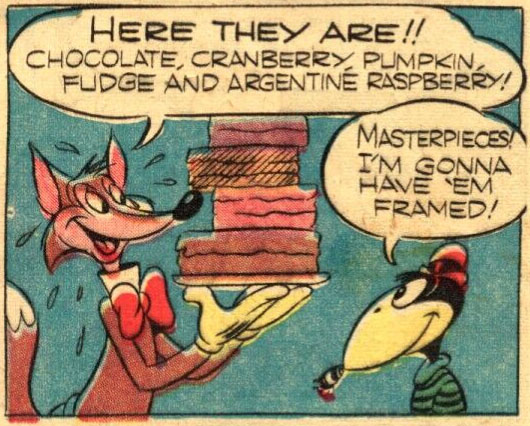
This week’s moonlighting animator in comics is animator and director Bob Wickersham! Not much is known about Wickersham. We hope this column will offer the most extensive information on him as of this writing.
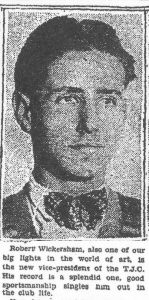 Born in 1910 in Colina, Mexico, Bob Wickersham’s cartooning career began at age 12, when he submitted his artwork for the “Junior Times,” a supplement in the Los Angeles Sunday Times. Many other young cartoonists received their start here before they entered animation; Cal Howard and Hardie Gramatky also submitted cartoons around the time of Wickersham’s earliest known work. He continued to draw for the “Junior Times” into the late 1920s, and created a featured strip — Fido Bark, a humanized dog character.
Born in 1910 in Colina, Mexico, Bob Wickersham’s cartooning career began at age 12, when he submitted his artwork for the “Junior Times,” a supplement in the Los Angeles Sunday Times. Many other young cartoonists received their start here before they entered animation; Cal Howard and Hardie Gramatky also submitted cartoons around the time of Wickersham’s earliest known work. He continued to draw for the “Junior Times” into the late 1920s, and created a featured strip — Fido Bark, a humanized dog character.
In the early 1930s, he joined Walt Disney’s studio, and became a full animator by 1933. He animated on several Mickey Mouse, Silly Symphonies and Donald Duck cartoons throughout the ‘30s. Wickersham worked on a few scenes in Snow White and the Seven Dwarfs and the “Sorcerer’s Apprentice” sequence in Fantasia, but was uncredited for his animation on both films. He left Disney to work at Max Fleischer’s studio in Miami, which offered a higher salary for preparation of their first feature film Gulliver’s Travels. He worked at Fleischer’s as an animator and story artist, contributing to several theatrical shorts and their second feature, Mr. Bug Goes to Town.
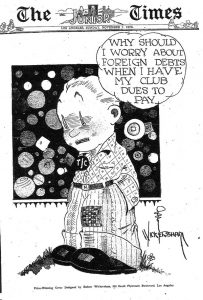 Wickersham returned to the West Coast in the early 1940s, where he joined Screen Gems, which produced cartoons distributed by Columbia Pictures, as an animator. He later became a director on several on the Color Rhapsodies, Phantasies and the films featuring the Fox and the Crow. By 1945, he went to work for James Davis’ shop, drawing comic book stories, published by Benjamin Sangor’s various magazines, with humans and funny animal characters. Later, he drew comics based on Screen Gems’ Fox and the Crow for DC, most of which were written by Hubie Karp. Wickersham and James Davis drew different stories with the characters within the same issued magazines — Davis eventually became the regular artist.
Wickersham returned to the West Coast in the early 1940s, where he joined Screen Gems, which produced cartoons distributed by Columbia Pictures, as an animator. He later became a director on several on the Color Rhapsodies, Phantasies and the films featuring the Fox and the Crow. By 1945, he went to work for James Davis’ shop, drawing comic book stories, published by Benjamin Sangor’s various magazines, with humans and funny animal characters. Later, he drew comics based on Screen Gems’ Fox and the Crow for DC, most of which were written by Hubie Karp. Wickersham and James Davis drew different stories with the characters within the same issued magazines — Davis eventually became the regular artist.
When Sangor abruptly ended work for Davis’ Los Angeles operations in the summer of 1948, Wickersham organized a studio called TV Spots, which specialized in animated commercials for television. The outgrowth of Wickersham’s studio led to its incorporation by October 1951. Through the late ‘40s and early ‘50s, he continued to draw comic book series— one featuring The Kellys for Marvel, and another with The Kilroys, both capitalizing on the teenaged audience for the popular Archie comics. Cal Howard often wrote the stories for the Kilroys magazine. (Wickersham also drew for another teen magazine, Cookie, published by Sangor in the late ‘40s.)
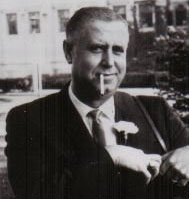 He went back into animation for a brief period at Warner Bros., animating for Bob McKimson’s unit. Wickersham is credited on two cartoons — Big Top Bunny (released late 1951) and Thumb Fun (released early 1952), though it’s possible he animated on more, without on-screen credit. His advertising career continued as a character designer, producer and director of the Jolly Green Giant commercials for Swift-Chaplin Productions. In 1955, producer Shull Bonsall bought TV Spots and shipped Wickersham to New York to manage an office there. During his time in New York, he went to work at Chadwick, Inc., where he became a president and partner of the company. Later, he moved to Chicago in January 1958 to work at the Leo Burnett advertising agency, as a copy supervisor, before his death in 1962 at age 51.
He went back into animation for a brief period at Warner Bros., animating for Bob McKimson’s unit. Wickersham is credited on two cartoons — Big Top Bunny (released late 1951) and Thumb Fun (released early 1952), though it’s possible he animated on more, without on-screen credit. His advertising career continued as a character designer, producer and director of the Jolly Green Giant commercials for Swift-Chaplin Productions. In 1955, producer Shull Bonsall bought TV Spots and shipped Wickersham to New York to manage an office there. During his time in New York, he went to work at Chadwick, Inc., where he became a president and partner of the company. Later, he moved to Chicago in January 1958 to work at the Leo Burnett advertising agency, as a copy supervisor, before his death in 1962 at age 51.
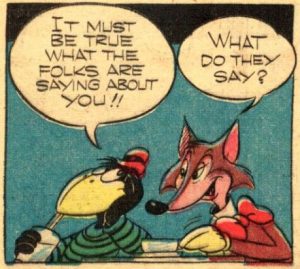 Here’s a sampling of Wickersham’s comic book stories, all from the mid- to late 1940s.
Here’s a sampling of Wickersham’s comic book stories, all from the mid- to late 1940s.
• “Wacky Wolf”—Giggle Comics #20 (June 1945)
• “The Fox and the Crow”—Real Screen Comics #7 (August-September 1946)
• “Cindy”—Cookie #6 (April-May 1947)
• “Peace and Quiet” (The Kilroys)—The Kilroys #7 (April 1948)
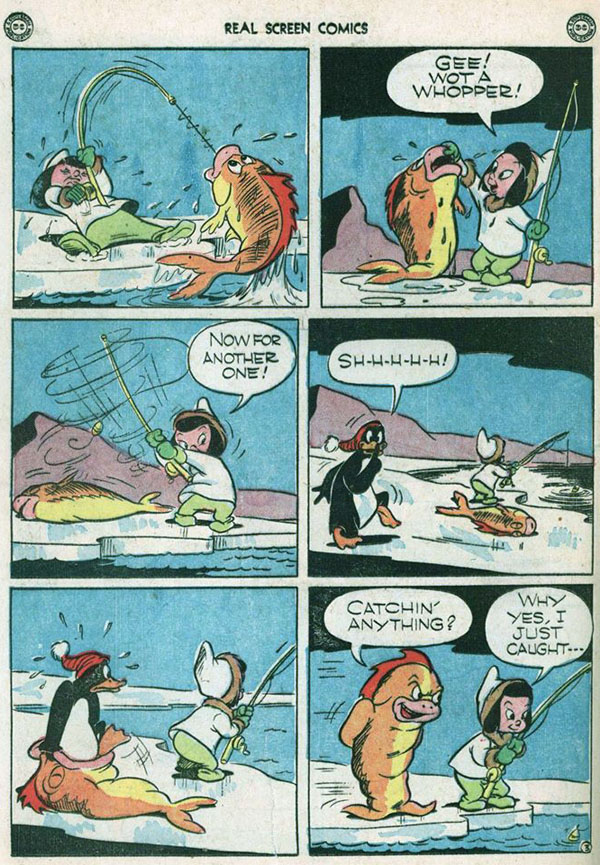
Next Week: A profile of an animator who served as Wickersham’s assistant at the Disney studio, and drew countless amounts of comic book stories for James Davis’ shop and Western Publishing.
(Thanks to Mark Kausler, Yowp, J.B. Kaufman, Hans Perk and Michael Barrier for their help.)


 DEVON BAXTER is a film restoration artist, video editor, and animation researcher/writer currently residing in Pennsylvania. He also hosts a
DEVON BAXTER is a film restoration artist, video editor, and animation researcher/writer currently residing in Pennsylvania. He also hosts a 



















































































Love that “Junior Times” artwork. Very reminiscent of Jerry on the Job..
So Wickersham eventually died a Mad Man! 😉
True ! 😁
The Real Screen Comics #13 story is most definitely not by Bob Wickersham. I’m fairly certain it’s by Otto Feuer.
Thanks Thad – that link has now been removed.
I hadn’t any idea Feuer even drew stories with the Fox and the Crow. Thanks for your help, Thad!
Wonder if Dr. Seuss named the Wickersham Brothers in “Horton Hears a Who” after him?
I can probably give you a pretty accurate page count for the “countless amounts” of comic book art that your next week’s ‘moonlighting animator’ did in his career! ;o) ;o)
Didn’t Wickersham also do some work for Timely/Marvel, doing a series called “The Kellys”?
Yes, and Devon mentioned it in his post.
Bob Wickersham was my ex-husband’s (Dave Wickersham) father…..his son (Todd Wickersham) was so happy to see this today! We never saw that young photo of him; thank you !!!
That is my dads uncle…His sister Elizabeth wickersham chapman was my grandma. Love all the family history ( some of which I heard thru dad and my aunts) documented!
This is my grandfather. My dad is Dave Wickersham. Grandfather died when I was very little but heard stories from my dad – love seeing all of this.